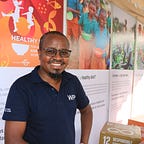“This is like a dream. I can now provide nutritious meals to my family.”
A promising harvest from the thirsty plains of Northern Kenya
Turkana experiences very high temperatures all year round and is one of the driest counties of Kenya. Water is scarce as the rainfall pattern is unpredictable and at times there is no rain in a whole year. The harsh environmental conditions translate into limited farming opportunities, enjoyed only by families living close to the one permanent water source— the Turkwell River. As a result, the residents of Turkana County are faced with a persistent threat of hunger.
Over 70,000 people living in Lodwar town, the capital of Turkana, rely on the markets for their food, most of which is brought in from the highlands over 300 kilometers away. The resulting high prices mean that nutritious food is not accessible for all families.
However the World Food Programme (WFP) is tackling the problem with a farming method allowing vegetables to grow in impossible places, using low-cost locally available material. Hydroponic trials, a method of growing plants using a nutrient rich solution and very little water, were made possible with support from Australia, Germany, and Japan. The pilot has evolved over the last nine months with each failure or success informing the next step.
Learning through doing
“Initially, we tried to grow fodder because this is primarily a livestock-keeping area,” says Angelica. “However, the community chose to grow vegetables because at the time, their livestock had enough fodder from the fields.”
WFP is using locally harvested sandy soils mixed with cured animal waste manure to increase the soil fertility. This is complemented with fertilizer if the plants show signs of lacking nutrients, for instance the leaves start turning yellow.
“Water is obviously our biggest challenge here in Turkana,” says James Wainaina, an agronomist contracted by WFP for technical support. “But the systems employed in the pilots all use very little water. In a day, we only need 20 litres to water roughly 150 plants.”
Promising results
WFP started the trials in two locations, growing leafy vegetables like spinach, kale, cow pea leaves and lettuces in various types of structures, including pyramid like circular cones, hydro crates, hanging gardens, and grow bags. Each unit holds more than 2,000 plants.
The results are promising. Such units could hold the key to ending high levels of malnutrition for households in Turkana. With just a little water and training, families can wave goodbye to long distances to markets and the high prices of vegetables.
In Kakwanyang, a village 20 kilometres from Lodwar town, mothers are already reaping the benefits of the innovative hydroponics farming. The group of women running this pilot is in the second round of harvesting.
Ayanai Lowoi is one of the women trained on good agronomic practices and now feels confident that she can run with the project.
“I never in my life thought that I would be able to grow my own vegetables right here,” she says. “This is like a dream. I can now provide nutritious meals to my family.”
In the second site, located at the Catholic compound in the town centre, the second harvest was impressive.
“We were able to harvest 14 kilos of leafy vegetables — spinach, lettuce, and cow pea leaves,” says Angelica. “The vegetables are shared among the women for their families. If the harvest is too large, they sell some in the market.”
Shaping future of cultivation
The hydroponics pilots concluded in December 2019 and will be assessed for their financial and technical worth. If found viable, WFP will work with the County Government to scale up the programme.
Already, the combination of using locally available material, easy to construct structures, and high proven yields is driving the fame of the hydroponics pilots in and around Lodwar.
Additional writing by Leornard Shikuku.
